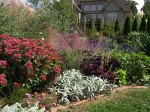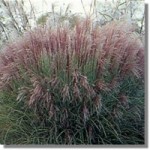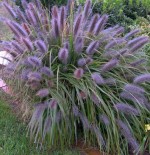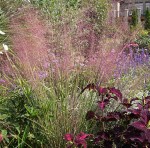 The cool temperatures of autumn allow fall blooming grasses to grow to their full potential. Some of them continue into winter providing beauty and interest well into spring. Many of them have flowers that also work well in fresh or dried bouquets so can be enjoyed for a very long time and at a time of year when little else is blooming. These are my top picks for fall blooming grasses.
The cool temperatures of autumn allow fall blooming grasses to grow to their full potential. Some of them continue into winter providing beauty and interest well into spring. Many of them have flowers that also work well in fresh or dried bouquets so can be enjoyed for a very long time and at a time of year when little else is blooming. These are my top picks for fall blooming grasses.
Silver Maiden grass (Miscanthus sinensis ‘Morning Light’)

Tall (4-5’) , silver variegated stalks bear showy light colored plumes touched with a pink blush from fall into winter. The rustling of the leaves when the wind blows adds a pleasant sound to the garden. The flower heads hold well and are especially attractive in fresh or dried arrangements. Full sun, zones 5-9, disease and pest resistant, easy to grow.
Dwarf Fountain Grass ‘Moudry’ (Pennisetum alopecuroides ‘Moudry’)

The dark purple flowers of this foxtail grass are stunning and catch the eye as soon as they come into bloom. With morning dew on them, they are awe inspriting! The flowers break down as fall progresses and are suitable for drying but they are fantastic in a fresh arrangement. The green foliage is a bit wider than other pennisetums and forms attractive clumps about 30” tall. Full sun, zones 5-9, easy to grow. Their only draw back is that they can become invasive if moisture is abundant but seedlings are easy to pull out.
Purple Muhly Grass (Muhlenbergia filipes)

When the light airy plumes of this lovely, delicate grass bloom they takes my breath away. Muhly grass is especially beautiful when planted in drifts with other ornamental grasses or with fall blooming plants such as mums . The plants without their flower heads are rather plain looking and so best tucked into area where other plants present a show in summer. Full sun, zones 7-9, pest and disease free, easy to grow.
Big Bluestem (Andropogon gerardii)

This native tallgrass prairie grass is a striking addition to the fall garden. Its forms upright clumps of blue-green to silvery-blue foliage that turns bronze in fall and bears purplish flower spikes in August and September. Because of its height (40-60+”) it is best used in the back of the border or as a specimen plant. The flowers are attractive in both fresh and dried arrangements. Full sun, zones 4-10, tolerates considerable drought and heat, no pests or diseases. Several cultivars are available including shorter ones.
Pampas Grass (Cortaderia selloana)

The architectural quality of pampas grass makes it a knockout in any garden. Growing over 9’ tall, they are great as back of the border plants for large fall blooming plants like New York asters. The summer foliage is light green and turns light tan in the fall. The huge 2-3’ long silver white flowering plumes are good for drying. Their size is their greatest virtue and greatest fault depending on the size of your garden but there is a compact cultivar, ‘Pumila’ that has gray-green leaves. The leaves are sharp and can cause painful cuts so this grass is best planted away from places where people might brush by it. Full sun, zones 7-11, tolerates drought, easy to grow.
These grasses are sensational with other grasses or in a perennial border. I have seen them used effectively in all parts of the country. If you have not grown grasses before, try one. You might find that is a valuable addition to your garden and will then try more.

All wonderful grasses. I’m glad to see the fall flowering qualities featured. The flowers make for such interesting color combinations, and the addition of movement to the garden is a major feature.
I’m especially fond of the purple muhly and big bluestem. They’re gorgeous native grasses that really still aren’t planted nearly enough. The only one I have some reservations about is pampas grass, and then only because it is often misused or mistreated in the landscape. A well grown pampas in the right place is a thing of glory.
The grasses are one of my favorite components of my garden but I have to admit that I lack the artistic ability to utilize them as well as possible. I have seen some gardens (and pictures of gardens like the one in the Dec issue of Fine Gardening) that really use grasses well and I keep plugging away hoping to ‘get the look’ right some day.
You are so right about the pampas grass and I hesitated to include it. But it IS a spectacular grass when not over used or used correctly. On a trip to southwestern Utah we saw some in yards that was really spectacular and so I couldn’t leave it out of the post.